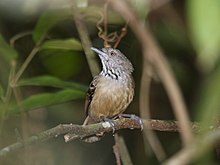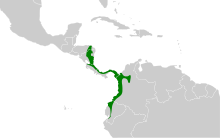The checker-throated stipplethroat (Epinecrophylla fulviventris), previously called fulvous-bellied antwren[2] or checker-throated antwren,[3] is a small passerine bird in subfamily Thamnophilinae of family Thamnophilidae, the "typical antbirds". It is found from Honduras to Ecuador.[4]
| Checker-throated stipplethroat | |
|---|---|

| |
| Scientific classification | |
| Domain: | Eukaryota |
| Kingdom: | Animalia |
| Phylum: | Chordata |
| Class: | Aves |
| Order: | Passeriformes |
| Family: | Thamnophilidae |
| Genus: | Epinecrophylla |
| Species: | E. fulviventris
|
| Binomial name | |
| Epinecrophylla fulviventris (Lawrence, 1862)
| |

| |
| Synonyms | |
| |
Taxonomy and systematics edit
The checker-throated stipplethroat was originally placed in genus Myrmotherula and then given the English name checker-throated antwren. Based on genetic and vocal studies it and seven other members of the genus were moved to the newly created genus Epinecrophylla. All were eventually named "stipplethroats" to highlight a common feature and to set them apart from Myrmotherulaantwrens.[5][6] [7] Though three subspecies have been proposed, that treatment has not gained acceptance and major taxonomic systems deem the species monotypic.[4][8][9]
Description edit
The checker-throated stipplethroat is 10 to 11 cm (3.9 to 4.3 in) long and weighs 8.5 to 11.5 g (0.30 to 0.41 oz). The sexes have nearly identical plumage. Males have a mostly gray face and a black throat with large white spots. Females have a mostly brownish buff face and throat. Adults of both sexes have a gray-brown crown and upperparts and a reddish tail. Their wing coverts are blackish brown to olive-brown with yellow-ochre tips and their flight feathers are reddish. Their breast is gray and the rest of their underparts are brownish buff that is darker towards the vent area. Their iris is golden that darkens with age. Juveniles have a gray iris that yellows as they mature.[10][11][12][13][14]
Distribution and habitat edit
The checker-throated stipplethroat is found on the Caribbean slope from far southeastern Honduras through Nicaragua and Costa Rica into western Panama, on both the Caribbean and Pacific slopes from western Panama into Colombia, east in Colombia into the Magdalena River valley, and south through western Colombia and Ecuador nearly to Peru. It inhabits evergreen forest in the lowlands and foothills and adjacent mature secondary forest. It favors areas with dense vine tangles that collect debris. In elevation it mostly ranges up to about 750 m (2,500 ft) in Central America, to 1,200 m (3,900 ft) in Colombia, and to 900 m (3,000 ft) in Ecuador. It does reach 900 m (3,000 ft) in Costa Rica and 2,000 m (6,600 ft) in Colombia.[10][11][12][13][14]
Behavior edit
Movement edit
The checker-throated stipplethroat is a year-round resident throughout its range.[10]
Feeding edit
The checker-throated stipplethroat feeds on arthropods, especially cockroaches (Blattidae), crickets (Gryllidae), katydids (Tettigoniidae), and spiders. It typically forages in pairs or in small family groups and less often by itself, and usually as part of a mixed-species feeding flock. It occasionally, and for short periods, attends army ant swarms. It mostly forages in the forest understory to mid-story; some studies found that it seldom exceeds 10 m (30 ft) above the ground, but others have noted it feeding as high as 25 m (80 ft). It forages mostly in vine tangles, on their foliage and in dead leaves and other debris trapped in them. It also forages by hitching along thin branches and capturing prey from their live leaves, in clumps of moss, and from epiphytes.[10][11][12][13][14]
Territorial defense edit
Male checker-throated stipplethroats display to each other from perches about 30 cm (12 in) apart; they lower their heads, puff up their plumage, sway back and forth, and continuously vocalize.[10]
Breeding edit
The checker-throated stipplethroat's breeding season varies somewhat in different areas. In Panama it appears to nest at any time but mostly in the rainy season. In Costa Rica it nests between March and August; in Colombia its season includes December but is not otherwise defined. Its nest is a deep pouch of plant fibers, fungal filaments, rootlets, and dead leaves with a lining of fine fibers. It is suspended from the last fork of a thin twig, usually below 2 m (7 ft) in a sapling but occasionally as high as 8 m (25 ft). The clutch size is two eggs; they have a white or cream base color with blotches, fine spots, and scrawls of reddish-brown, purplish-chestnut, and pale lilac. Both parents incubate the clutch during the day and the female alone at night. The incubation period is 18 to 20 days. Both parents provision nestlings; the time to fledging is not known.[10]
Vocalization edit
The checker-throated stipplethroat's song is a "series of abrupt, countable, almost stacatto notes...variable in pace, pitch and intensity, but often accelerates and intensifies initially and decelerates and dies off slightly at end.[10] It has been further described as "a descending series of high-pitched notes, 'seee, seee, seeu, seeu' ".[14] Its calls include "a fast rattle and a 'peeyk' note".[14]
Status edit
The IUCN has assessed the checker-throated stipplethroat as being of Least Concern. It has a large range; its population size is not known and is thought to be decreasing. No immediate threats have been identified.[1] It is considered fairly common across its range and occurs in several protect areas. "Continued protection of the forests in these and other existing reserves should ensure the maintenance of viable populations of this species."[10]
References edit
- ^ a b BirdLife International (2018). "Checker-throated Stipplethroat Epinecrophylla fulviventris". IUCN Red List of Threatened Species. 2018: e.T22701469A130212748. doi:10.2305/IUCN.UK.2018-2.RLTS.T22701469A130212748.en. Retrieved 11 January 2024.
- ^ Wetmore, A. 1972. The birds of the Republic of Panamá, part 3. Smithsonian Miscellaneous Collections 150.
- ^ Check-list of North American Birds (7th ed.). Washington, D.C.: American Ornithologists' Union. 1998.
- ^ a b Gill, Frank; Donsker, David; Rasmussen, Pamela, eds. (January 2024). "Antbirds". IOC World Bird List. v 14.1. Retrieved January 4, 2024.
- ^ Remsen, J. V., Jr., J. I. Areta, E. Bonaccorso, S. Claramunt, G. Del-Rio, A. Jaramillo, D. F. Lane, M. B. Robbins, F. G. Stiles, and K. J. Zimmer. Version 26 November 2023. A classification of the bird species of South America. American Ornithological Society. https://www.museum.lsu.edu/~Remsen/SACCBaseline.htm retrieved November 27, 2023
- ^ Irestedt, Martin ; Fjeldså, Jon; Nylander, Johan A. A. & Ericson, Per G. P. (2004): Phylogenetic relationships of typical antbirds (Thamnophilidae) and test of incongruence based on Bayes factors. BMC Evol. Biol. 4: 23. doi:10.1186/1471-2148-4-23 Supplementary information Archived 2016-04-11 at the Wayback Machine
- ^ Isler, M., D. Lacerda, P. Isler, S. Hackett, K. Rosenberg, and R. Brumfield (2006). Epinecrophylla, a new genus of antwrens (Aves: Passeriformes: Thamnophilidae). Proceedings of the Biological Society of Washington 119(4): 522–527
- ^ Clements, J. F., P.C. Rasmussen, T. S. Schulenberg, M. J. Iliff, T. A. Fredericks, J. A. Gerbracht, D. Lepage, A. Spencer, S. M. Billerman, B. L. Sullivan, and C. L. Wood. 2023. The eBird/Clements checklist of birds of the world: v2023. Downloaded from https://www.birds.cornell.edu/clementschecklist/download/ retrieved October 28, 2023
- ^ HBW and BirdLife International (2023). Handbook of the Birds of the World and BirdLife International digital checklist of the birds of the world. Version 8. Available at: http://datazone.birdlife.org/userfiles/file/Species/Taxonomy/HBW-BirdLife_Checklist_v8_Dec23.zip retrieved December 28, 2023
- ^ a b c d e f g h Zimmer, K., M.L. Isler, and D. A. Christie (2020). Checker-throated Stipplethroat (Epinecrophylla fulviventris), version 1.0. In Birds of the World (J. del Hoyo, A. Elliott, J. Sargatal, D. A. Christie, and E. de Juana, Editors). Cornell Lab of Ornithology, Ithaca, NY, USA. https://doi.org/10.2173/bow.chtant1.01 retrieved January 11, 2024
- ^ a b c vanPerlo, Ber (2006). Birds of Mexico and Central America. Princeton Illustrated Checklists. New Jersey: Princeton University Press. pp. plate 60. ISBN 0691120706.
- ^ a b c Garrigues, Richard; Dean, Robert (2007). The Birds of Costa Rica. Ithaca: Zona Tropical/Comstock/Cornell University Press. p. 182-183. ISBN 978-0-8014-7373-9.
- ^ a b c McMullan, Miles; Donegan, Thomas M.; Quevedo, Alonso (2010). Field Guide to the Birds of Colombia. Bogotá: Fundación ProAves. p. 132. ISBN 978-0-9827615-0-2.
- ^ a b c d e Ridgely, Robert S.; Greenfield, Paul J. (2001). The Birds of Ecuador: Field Guide. Vol. II. Ithaca: Cornell University Press. p. 405. ISBN 978-0-8014-8721-7.
Further reading edit
- Skutch, Alexander F. (1969). "Fulvous-bellied antwren" (PDF). Life Histories of Central American Birds III: Families Cotingidae, Pipridae, Formicariidae, Furnariidae, Dendrocolaptidae, and Picidae. Pacific Coast Avifauna, Number 35. Berkeley, California: Cooper Ornithological Society. pp. 219–221.
- Stiles, F. Gary & Skutch, Alexander Frank (1989): A guide to the birds of Costa Rica. Comistock, Ithaca. ISBN 0-8014-9600-4
